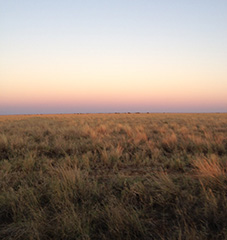 From paddock to plate, Australia's Red Meat and Livestock industry makes an important contribution to sustainability—environmental, economic and social.
From paddock to plate, Australia's Red Meat and Livestock industry makes an important contribution to sustainability—environmental, economic and social.
With their unique production systems and commitment to striving for continuous improvement, Australia's ranchers are recognized around the world as leaders in producing some of the world’s best red meat, while leading the way in environmental farming practices.
The Cowper Ranch
Andrew and Lesley Cowper have been ranching in Australia for decades. For the last thirteen years, they’ve managed their own 18,226-acre ranch in the grasslands of Central Western Queensland, raising Merino (wool-producing) sheep and Santa Gertrudis cattle (a breed that originated in Texas, USA), and also joining their cull ewes to White Suffolk rams for the prime lamb market. Hard work and sustainable, responsible ranching have always been key drivers of their operation.
A Day in the Life
On a typical day, Andrew and Lesley are up at 5 a.m. (or 6 a.m. in winter). After breakfast (which often includes an Australian Lamb chop), they begin to tackle their to-do list: stock work, mustering, fencing, delving the bore drains (streams that flow from an artesian bore through the paddocks to provide water to stock), vehicle maintenance, and overseeing sheep and lamb shearing, crutching, and marking. During Australia’s scorching summers, a midday break is a must to beat the heat, which regularly tops 100 degrees Fahrenheit.
A Healthy Environment
"We have hundreds of thousands of square miles of semi-arid country ideally suited to the raising of livestock (and not much else). It's a very healthy environment for stock, with limited requirements for chemicals," says Andrew, of what sets Australian ranching (and its product) apart.
Like many Australian ranchers, the Cowpers realize the importance of keeping both their land and their stock in excellent condition. Energy-saving windmills are used for watering stock. They try to stock according to the season, and constant upgrading of the quality of the stock with rigorous culling is also a priority. They shear early in January and lamb in early March, when they've ideally got green feed (grass) from the wet summer season, a condition that contributes to optimum animal health.
To encourage the regeneration of native trees and shrubs, the Cowpers have also stocked their ranch more lightly than it had been previously, and they try to keep their mobs of sheep and cattle at less than the recommended stocking rate. Additionally, they have protected little trees from the stock by “pig-penning” old fence posts around them. Paddocks are either sub-divided or dedicated to different types of stock in a manner that accommodates the grazing behavior of both sheep and cattle, and also works to prevent erosion and promote re-grassing. In general, "we've always run our operation very simply," says Lesley.
Lamb Fans
When they're not hard at work, Andrew and Lesley like to kick back and enjoy some Australian Lamb. Here’s a great-for-spring recipe inspired by their favorite dish, roast lamb with mint sauce and baked vegetables.
For more on the sustainability practices and initiatives of Australia’s ranchers, click here.

